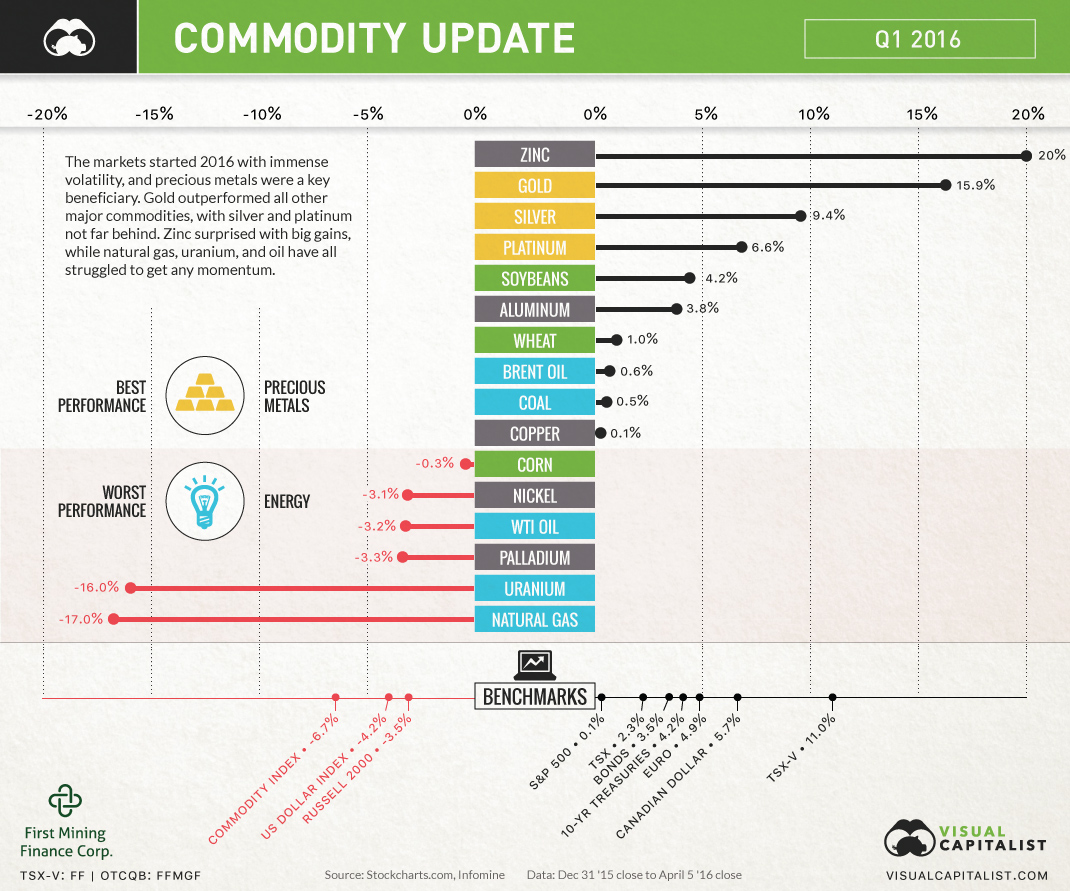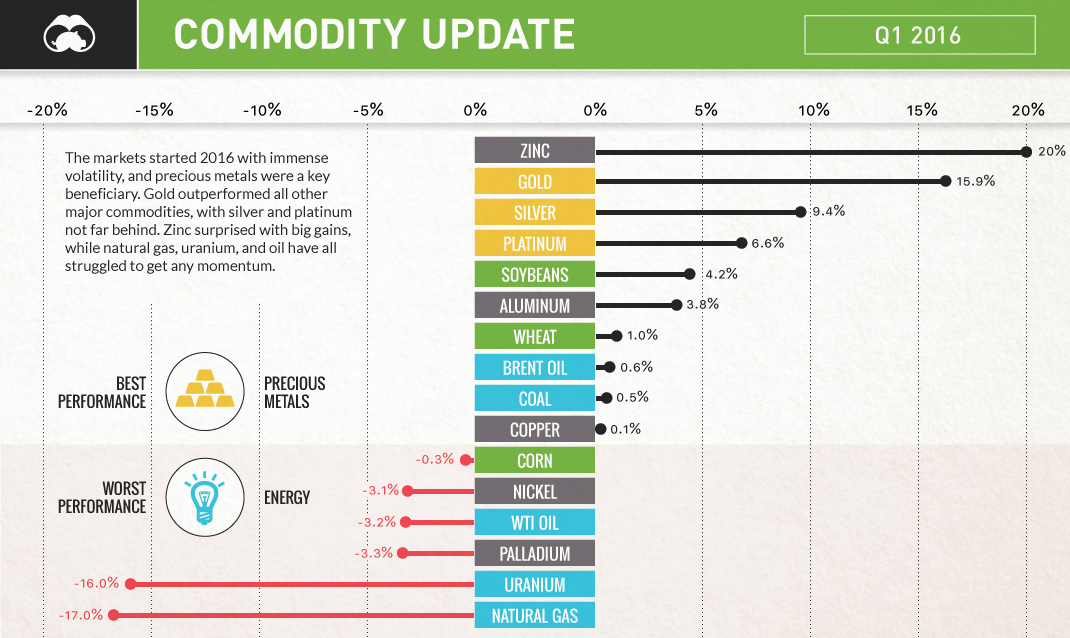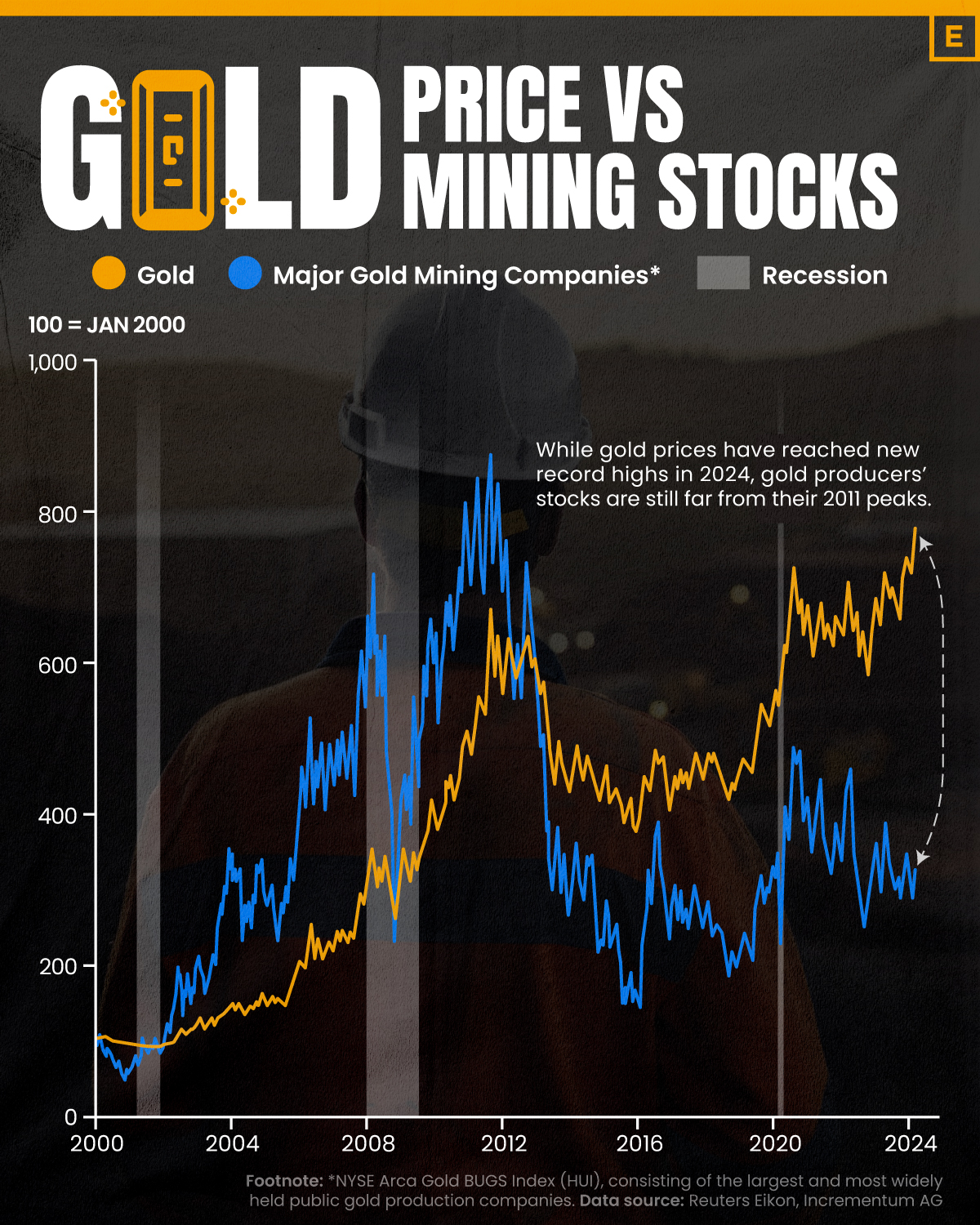Mining
Commodities: Gold and Zinc Crush it in Q1, Energy Gets Smoked

Commodities: Gold and Zinc Crush it in Q1, Energy Gets Smoked
The start of 2016 has been a roller coaster for investors.
Global markets had their worst ever start in the first trading days of the year, with the S&P 500 eventually shedding 10.5% by early February. Stocks have rebounded since then, but tension is still in the air with record longs on the VIX Volatility Index.
Precious Metals
For this reason, among many others, investors piled into precious metals in Q1 of 2016. Gold finished up an impressive 15.9%, buoyed by record buying in gold ETFs. Meanwhile, silver and platinum, which are considered precious metals with more industrial uses, were also up in Q1 to a lesser extent: 9.4% and 6.6% respectively.
Base Metals
Base metals were all over the map in the first few months of the year. Zinc shot up a surprising 20%, though it has been overdue for a bounce back since hitting five-year lows in 2015. Nickel and copper, however, did not perform as admirably. Nickel was in negative territory (-3.1%) and copper ultimately ended up flat, despite a large rally in February and early-March.
Energy
The energy sector had no real winners, with WTI crude, natural gas, and uranium all ending up in the red. Natural gas was the worst of these with a steep -17.0% drop as it continues to eye multi-decade lows. Some analysts expect more downward pressure on natural gas now that the quantity of gas in storage is 34.2% higher than the five-year average.
Food
The world’s key agricultural commodities were a mixed bag in terms of performance. Soybeans jumped 4.2% in value, but wheat (1.0%) and corn (-0.3%) only had subtle changes in prices.
With many looming questions for Q2, we’re sure that our next quarterly update will be just as eventful. Concerns around a potential Brexit, negative interest rates, stagnating manufacturing, and a potential U.S. rate hike could make for a particularly interesting time period.
Chart presented by: First Mining Finance Corp.
Mining
Charted: The Value Gap Between the Gold Price and Gold Miners
While the price of gold has reached new record highs in 2024, gold mining stocks are still far from their 2011 peaks.

The Value Gap Between the Gold Price and Gold Miners
This was originally posted on our Voronoi app. Download the app for free on Apple or Android and discover incredible data-driven charts from a variety of trusted sources.
Although the price of gold has reached new record highs in 2024, gold miners are still far from their 2011 peaks.
In this graphic, we illustrate the evolution of gold prices since 2000 compared to the NYSE Arca Gold BUGS Index (HUI), which consists of the largest and most widely held public gold production companies. The data was compiled by Incrementum AG.
Mining Stocks Lag Far Behind
In April 2024, gold reached a new record high as Federal Reserve Chair Jerome Powell signaled policymakers may delay interest rate cuts until clearer signs of declining inflation materialize.
Additionally, with elections occurring in more than 60 countries in 2024 and ongoing conflicts in Ukraine and Gaza, central banks are continuing to buy gold to strengthen their reserves, creating momentum for the metal.
Traditionally known as a hedge against inflation and a safe haven during times of political and economic uncertainty, gold has climbed over 11% so far this year.
According to Business Insider, gold miners experienced their best performance in a year in March 2024. During that month, the gold mining sector outperformed all other U.S. industries, surpassing even the performance of semiconductor stocks.
Still, physical gold has outperformed shares of gold-mining companies over the past three years by one of the largest margins in decades.
| Year | Gold Price | NYSE Arca Gold BUGS Index (HUI) |
|---|---|---|
| 2023 | $2,062.92 | $243.31 |
| 2022 | $1,824.32 | $229.75 |
| 2021 | $1,828.60 | $258.87 |
| 2020 | $1,895.10 | $299.64 |
| 2019 | $1,523.00 | $241.94 |
| 2018 | $1,281.65 | $160.58 |
| 2017 | $1,296.50 | $192.31 |
| 2016 | $1,151.70 | $182.31 |
| 2015 | $1,060.20 | $111.18 |
| 2014 | $1,199.25 | $164.03 |
| 2013 | $1,201.50 | $197.70 |
| 2012 | $1,664.00 | $444.22 |
| 2011 | $1,574.50 | $498.73 |
| 2010 | $1,410.25 | $573.32 |
| 2009 | $1,104.00 | $429.91 |
| 2008 | $865.00 | $302.41 |
| 2007 | $836.50 | $409.37 |
| 2006 | $635.70 | $338.24 |
| 2005 | $513.00 | $276.90 |
| 2004 | $438.00 | $215.33 |
| 2003 | $417.25 | $242.93 |
| 2002 | $342.75 | $145.12 |
| 2001 | $276.50 | $65.20 |
| 2000 | $272.65 | $40.97 |
Among the largest companies on the NYSE Arca Gold BUGS Index, Colorado-based Newmont has experienced a 24% drop in its share price over the past year. Similarly, Canadian Barrick Gold also saw a decline of 6.5% over the past 12 months.
-

 Business2 weeks ago
Business2 weeks agoAmerica’s Top Companies by Revenue (1994 vs. 2023)
-

 Environment1 week ago
Environment1 week agoRanked: Top Countries by Total Forest Loss Since 2001
-

 Markets1 week ago
Markets1 week agoVisualizing America’s Shortage of Affordable Homes
-

 Maps2 weeks ago
Maps2 weeks agoMapped: Average Wages Across Europe
-

 Mining2 weeks ago
Mining2 weeks agoCharted: The Value Gap Between the Gold Price and Gold Miners
-

 Demographics2 weeks ago
Demographics2 weeks agoVisualizing the Size of the Global Senior Population
-

 Misc2 weeks ago
Misc2 weeks agoTesla Is Once Again the World’s Best-Selling EV Company
-

 Technology2 weeks ago
Technology2 weeks agoRanked: The Most Popular Smartphone Brands in the U.S.













